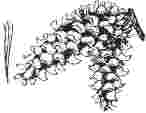 Southwestern white pine (2). | Pinus strobiformis Engelmann 1848Common NamesMexican white pine, southwestern white pine (2), pino blanco, pinabete (3), pino enano (5).Taxonomic notesSection Cembra. Syn: Pinus ayacahuite Ehrenberg var. brachyptera G.R. Shaw; P. ayacahuite var. reflexa (Engelmann) Voss; P. ayacahuite var. strobiformis (Engelmann) Lemmon; P. flexilis E. James var. reflexa Engelmann; P. reflexa (Engelmann) Engelmann (5).Forms a hybrid swarm with Pinus ayacahuite var. brachyptera in much of its range (3). DescriptionTrees to 15-24(30) m tall and 50-90 cm diameter, slender, straight; crown conic, becoming rounded to irregular. Bark gray, aging red-brown, furrowed, with narrow, irregular, scaly ridges. Branches spreading-ascending; twigs slender, pale red-brown, puberulous or glabrous, sometimes glaucous, aging gray or gray-brown, smooth. Buds ellipsoid, red-brown, ca. 1 cm, resinous. Needles 5 per fascicle, spreading to ascending-upcurved, persisting 3-5 years, 4-9 cm × 0.6-1 mm, straight, slightly twisted, pliant, dark green to blue-green, abaxial surface without evident stomatal lines, adaxial surfaces conspicuously whitened by narrow stomatal lines, margins sharp, razorlike and entire to finely serrulate, apex narrowly acute to short-subulate; sheath 1.5-2 cm, shed early. Staminate cones cylindric, ca. 6-10 mm, pale yellow-brown. Ovulate cones maturing in 2 years, shedding seeds and falling soon thereafter, pendent, symmetric, lance-cylindric before opening, broadly lance-cylindric when open, 15-25 cm, creamy brown to light yellow-brown, stalks to 6 cm; apophyses somewhat thickened, strongly cross-keeled, tip reflexed; umbo terminal, low. Seeds ovoid; body 10-13 mm, red-brown, essentially wingless. 2n=24 (4, 5).RangeUS: Arizona, New Mexico, Texas; Mexico: Coahuila, Nuevo León, Sonora, Chihuahua, Sinaloa, Durango; at 1900-3000 m (3, 5). Habitat dry rocky slopes in high mountains, or as a minor component in mixed conifer forests (4).Big TreeDiameter 150 cm, height 34 m, crown spread 19 m, located in Lincoln National Forest, NM (6).OldestDendrochronologyEthnobotanyThe seeds were eaten by natives of the southwest U.S. (4).ObservationsRemarks"In the northern part of the range, Pinus strobiformis overlaps P. flexilis and reportedly hybridizes with it. On average P. strobiformis has longer, more slender leaves and thinner, more spreading-tipped apophyses than are found in P. flexilis, and stomatal bands are not evident on the abaxial surface of its leaves" (5).White pine blister rust. (Cronartium ribicola), an introduced fungal disease, attacks this and certain other white pines (4). Citations(1) Silba 1986.(2) Elias 1987. (3) Perry 1991. (4) Little 1980. (5) Kral in Flora of North America online. (6) American Forests 1996 See also FEIS database. |
[Pinus] [Pinaceae] [home] This page is from the Gymnosperm Database |